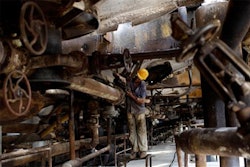 By MICHAEL COLLINS, Author, Saving American Manufacturing
By MICHAEL COLLINS, Author, Saving American Manufacturing
In the early 1960s the psychobioligist Roger W.Sperry came up with a breakthrough discovery that proved that the left and right hemispheres of the brain do not process the same information. Using a series of experiments with stroke victims Sperry proved, “The left side examines details and processes them logically and analytically but lacks a sense of overriding, abstract connections. The right side is more imaginative and intuitive and tends to work holistically, integrating pieces of an informational puzzle into a whole.”[1]This led to the general acceptance that the left brain is analytical and the right brain the seat of creativity.
For many decades we have been in an information age dominated by engineers, computer science, programmers and other left brain thinkers. In Daniel Pink’s book “A Whole New Mind” he makes the case that we are in the transition from the information age to the conceptual age and from L-Directed thinking to R-Directed thinking. Pink defines L-directed (left brain) thinking in terms of logic, sequence, literalness, and analysis; and R-directed (right brain) thinking in terms of synthesis, emotional expression, context, creativity and the big picture.
This transition to R-directed thinking and the conceptual age is based on the fact that we are slowly losing many L-directed jobs to foreign workers because any work that can be reduced to rules such as programming, building computers, reading x-rays, basic engineering are in danger, because technical workers in foreign countries can do the same work at 1/5 of the cost. Pink says that “American workers need to do what workers abroad cannot do equally well for much less money- using R-directed abilities such as forging relationships rather than executing transactions, tackling novel challenges instead of solving routine problems, and synthesizing the big picture rather than analyzing a single component”.[2] .
A second factor that is affecting the move to a conceptual age is the relentless use of automation in American factories which eliminates basic low skilled manufacturing jobs. But at the same time automation demands service, maintenance, repair and troubleshooting that require people who are masters of many aptitudes and skills. These people will rely more on creativity then competence, more on tacit knowledge then technical manuals and more on seeing the bigger picture and relying on intuition. Although some of the aptitudes Pink says are needed, seem a little ethereal — like spirituality, telling stories, and play — he does make some good points on why right brain thinking is needed to compete.
Synthesis — Pink says, “What’s in greatest demand today is not just analysis but synthesis- seeing the big picture and crossing boundaries, being able to combine disparate pieces into an arresting new whole.”2 I have always referred to this as the ability to see patterns in things that would lead to a holistic view.
I can see the wisdom of this claim in terms of manufacturing because I think that growing American manufacturing in the U.S. is all about innovation, new products, new customers, and market opportunities which are better understood by right brain methods.
This ability is also very useful in marketing, where you gather all kinds of data from the field on customers, prospects, and eventually see the trends and target a market. The very best Strategic and Marketing thinkers I have met in my career seem to have the ability to gather all kinds of disparate data and then use their intuition to see the patterns and make projections of where they should go in the future. On the other hand, I have tried (many times) to teach subjects that require Synthesis to people dominated by left brained thinking and found that most concepts simply do not register.
Design — Pink suggests that the difference between function and design is bringing together disparate things into a solution that is very unique. He makes the case that in a global world where Asian competitors can use the same technology to make a product with the same performance features and at a lower price; the only way to compete is by unique design.
Designing new complex products will still require a lot of engineering, programming and other technical people, but designing a product that will sell enough units to justify the costs may require design and thinking about intangible issues like being able to understand customer needs and wants, anticipating market trends and requirements, .and being able to see patterns. Essentially he is suggesting that design requires holistic thinking which includes information beyond the basic product concept.
To me, a unique design needs to take into consideration external factors that left-brained people often miss or ignore. Market factors like existing competitor designs, special customer needs, and focusing on a market niche where you can gain competitive advantage. An ideal new product would include features and advantages that are not easily copied by foreign competitors such as offering special services with the product.
I have seen many examples of manufacturers who think they have created a unique design only to find out later that the product does not really have a competitive advantage. Maybe the answer for engineering designs is to create teams that include both right- and left-brained people as part of the early design concepts.
Please tune into the Chemical Equipment Daily for part two of this two-part series. What’s your take? Please feel free to comment below!
[1] Unleashing Creativity, Ulrich Kraft, Scientific American 2005.
[2] A WHOLE NEW MIND, Daniel H.Pink, Riverhead books, New York, 2005.






















